One Year After Irma, Everglades City Struggles to Rebuild
Podcast: Play in new window | Download
State climate change denial leaves coastal communities on their own to face the risks.
By Amy Green
Florida Center for Investigative Reporting
This report, part of an FCIR series on climate change, was produced in partnership with WMFE, the NPR member station in Orlando. Click on the player below to hear a radio version.
EVERGLADES CITY – Three presidents have slept in Tina Collins’ home.
Her mint-colored cottage sheltered Franklin Roosevelt, Harry Truman, Dwight Eisenhower and other VIP guests to this frontier outpost of the southwest Florida wilderness, where the Barron River, Everglades and Gulf of Mexico converge.
Collins’ fondest memories of her 23-year home involve her husband and high school sweetheart Richard and their three children — James, 13, Katie, 12, and Gina, 11 — gathered on the expansive porch as Richard, a commercial stone crabber, motored by on the river.
More recent memories are not as sweet. One afternoon in August, Collins pushed open the door and stepped inside the dark, musty, dirty house.
“I don’t like staying here very long because I don’t like being exposed to the mold and stuff,” the 48-year-old Collins said quietly. “It’s not a healthy place.”
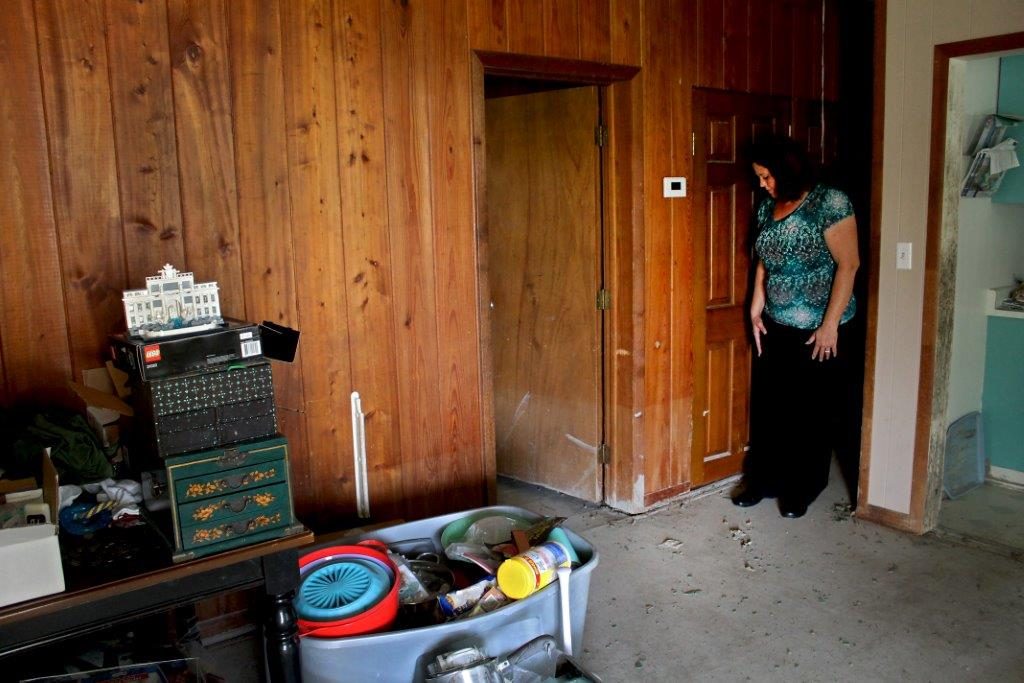
Tina Collins’ home once sheltered presidents and other VIP guests to Everglades City. She and her husband plan to knock down the house and rebuild on stilts. Photo by Amy Green
The power was out. The furniture was broken. Black mold gripped the white frame of a door leading into the kitchen, with bright teal cabinets Collins had painted. Stacked boxes were filled with the children’s old Halloween costumes and toys, things to be thrown away. Collins walked over to a wall paneled with original Dade County pine faded up to her knees — the height of the flood.
It’s been a long, challenging year for Collins and her family.
Since Hurricane Irma roared through Everglades City and up the Florida peninsula on Sept. 10, 2017, leaving almost no part of the state untouched, the Collins family has rented a ranger’s house in Everglades National Park while keeping up the mortgage payments on their shell of a home.
Eventually the Collins family plans to knock down the black mold-infested home and rebuild on stilts, but they don’t know when they will receive the money from their insurance company or how long they can continue to live temporarily in Everglades National Park.
“We’re all safe, and that’s what matters,” said Collins, who works in the administrative office of Big Cypress National Preserve, up the highway from Everglades City.
Irma was the most powerful hurricane ever recorded in the open Atlantic Ocean, a Category 5 monster with winds topping out at 185 miles an hour. The hurricane lost intensity before making landfall as a Category 4. Coming weeks after Harvey’s deluge in Houston, Texas, Irma marked the first time two Category 4 storms hit the U.S. in the same year.
No state is more exposed to the dangers of hurricanes and storm surges than Florida, where by century’s end the total value of homes at risk for chronic inundation is projected to be more than $351 billion in today’s dollars, the highest amount of any coastal state, according to the Union of Concerned Scientists, an advocacy organization.
Hurricanes are forecast to grow more destructive with climate change, as warmer waters boost intensity and rising tides push storm surges like that experienced by Everglades City higher and farther inland.
By 2100, about 40 percent of the at-risk homes in the entire United States will be in Florida, where today this real estate generates $5 billion annually in property tax revenue. Nearly a quarter of these homes were built after 2000, a testament to Florida’s brazen coastal building despite the risks.
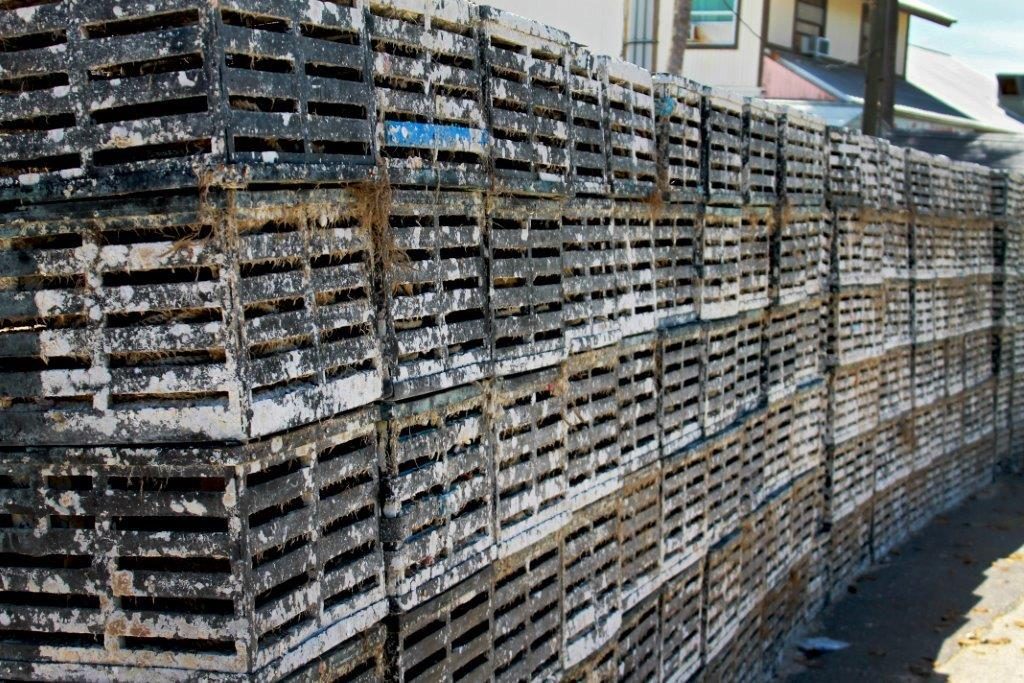
Everglades City bills itself as the Stone Crab Capital of the World. Photo by Amy Green
Irma ended up in Everglades City after early forecasts showed the hurricane making landfall in densely populated South Florida before following a path straight up the state’s center. Instead, the hurricane walloped Florida with a one-two punch, making landfall on Cudjoe Key and then hours later on Marco Island, about 18 miles south of Naples. Everglades City bore the brunt of this second landfall when the hurricane pushed a devastating storm surge into the remote village. Everything not on stilts flooded.
Irma was responsible for 84 deaths in Florida and nearly $10 billion in insurance claims.
The uncertainty about Irma’s path led to the largest hurricane evacuation in U.S. history. Some 7 million Floridians left home to seek shelter elsewhere.
Today, the uncertainty underscores the fact that Everglades City’s storm surge could have happened anywhere. The community’s recovery — now a year in the making — is a window into the future for coastal communities across Florida in a warming world. Gov. Rick Scott’s climate change policy of denial has left the state to focus after disasters on how to build rather than where to build.
“There are a lot of different ways that if we acknowledge these problems now that we can actually help people save money, help keep people safer and make for a future where hopefully some of these events are less catastrophic,” said Thomas Ruppert, a coastal planning specialist for Florida Sea Grant, an education and research organization focused on coastal resources at the University of Florida.
“The longer we continue to pretend that our coastal areas and the hazards they face are not changing,” Ruppert said, “the more we are promoting a future where events will be increasingly catastrophic.”
___
Few places in Florida are as remote as Everglades City. The community of some 450 year-round residents spreads out from the Barron River’s east bank in layers of cottages and stilted homes, with a gleaming white city hall at the center.
Irma was not the first hurricane to destroy the community. Damage from Hurricane Donna in 1960 was so severe that Collier County moved its seat to East Naples.
The resilience of Everglades City’s residents traces back to soon after the Civil War, when the first settlers arrived in search of a frost-free climate, although long before that the wilderness here harbored Native Americans fleeing the Indian Wars and slaves escaped from the Confederate states. The same wilderness ensured the settlers’ self-reliance. With no roads, the closest doctor was a six-hour boat trip away in Key West.
Today, 1 million visitors pass through Everglades City annually on their way into the Everglades or the sprinkling of islands just off shore in the Gulf of Mexico, and many locals make a living as airboat tour guides, fishing guides or stone crabbers. Everglades City bills itself as the Stone Crab Capital of the World.
Now, Hurricane Irma has threatened to change all that.
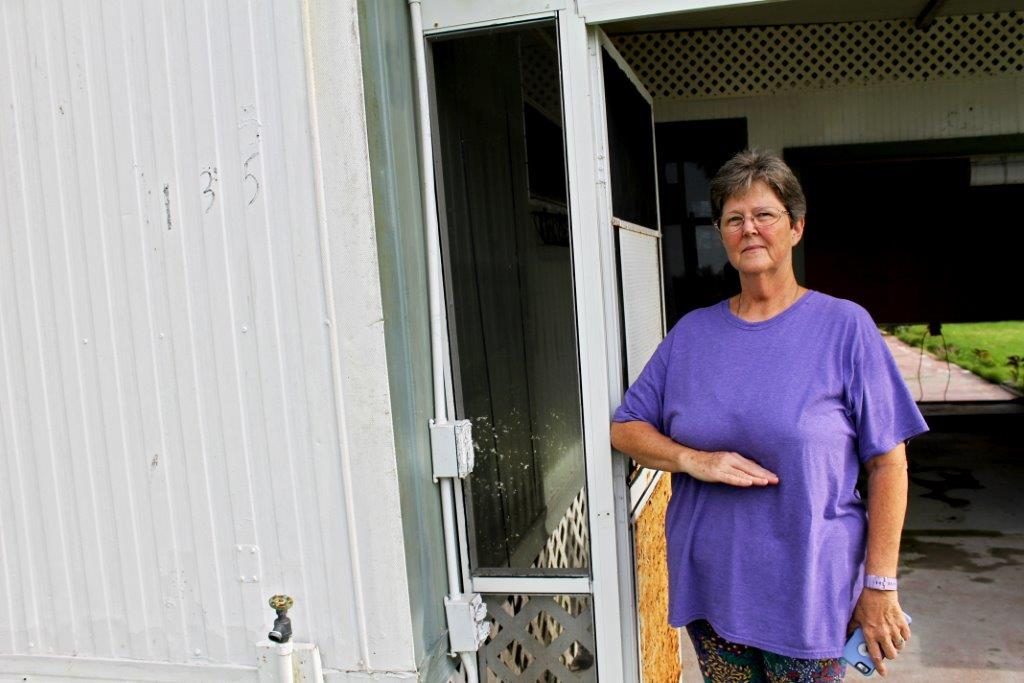
Lisa Marteeny waded through chest-high water with her husband Lee and their pug mix Killer to escape their flooding trailer. Photo by Amy Green
After the storm made landfall, water began rising through the floorboards of Lisa Marteeny’s mobile home on a canal of the Barron River.
Marteeny knew it was time to go. She grabbed the couple’s pug mix Killer and waded to a neighbor’s home on stilts, Killer doggy-paddling alongside her. Then she returned for Lee, who suffered from heart problems. Marteeny helped her husband to his feet, and together the couple made it safely next door.
“It was so loud, and the blowing and the whistling from the wind, we couldn’t even hardly hear each other unless we were close,” Marteeny recalled, describing an apocalyptic scene. “You had roofs flying all over the place and water rushing in. A refrigerator went down the street. It was very scary.”
Less than a week later, Lee, 72, was dead. The couple had lived in the trailer for 12 years.
The disaster of Everglades City’s storm surge continued, even after the water receded.
The next danger came from the mud. It was everywhere, with fecal contamination so severe that county scientists found it was beyond measure. One man’s leg had to be amputated because of infection. Tina Collins had just enough gasoline to drive to Marco Island to have an infected leg wound treated.

Lee Marteeny was 72. Photo courtesy Lisa Marteeny
A few days after Hurricane Irma blew through, Marteeny said open wounds on her husband Lee’s legs grew hot and turned black. He began vomiting and experiencing excruciating pain. An ambulance from Naples took nearly an hour to arrive, and Lee never regained consciousness. He died five days after Irma.
Marteeny spent the following months with friends and in a trailer provided by the Federal Emergency Management Agency.
“Our town is kind of like a ghost town,” said Marteeny, 63, who works in the water billing office of Everglades City. “It’s kind of sad because there’s whole families that are gone, that have to live somewhere else. I think there might be still people living in cars, or they’re living in their homes, and it’s truly not safe from the bacteria and the mold and all of that stuff.”
Hurricane Irma took a huge toll on Everglade City — some 60 percent of Everglades City’s homes were condemned. Dozens must be put on stilts under a National Flood Insurance Program rule requiring that if more than half of the structure is damaged, it must be brought up to current building codes.
Nearly a quarter of residents here have yet to return home. Some are awaiting grant and insurance money. Others are having trouble hiring contractors. There just aren’t enough contractors and handymen in the area, and few are willing to make the trip from Naples or Marco Island.
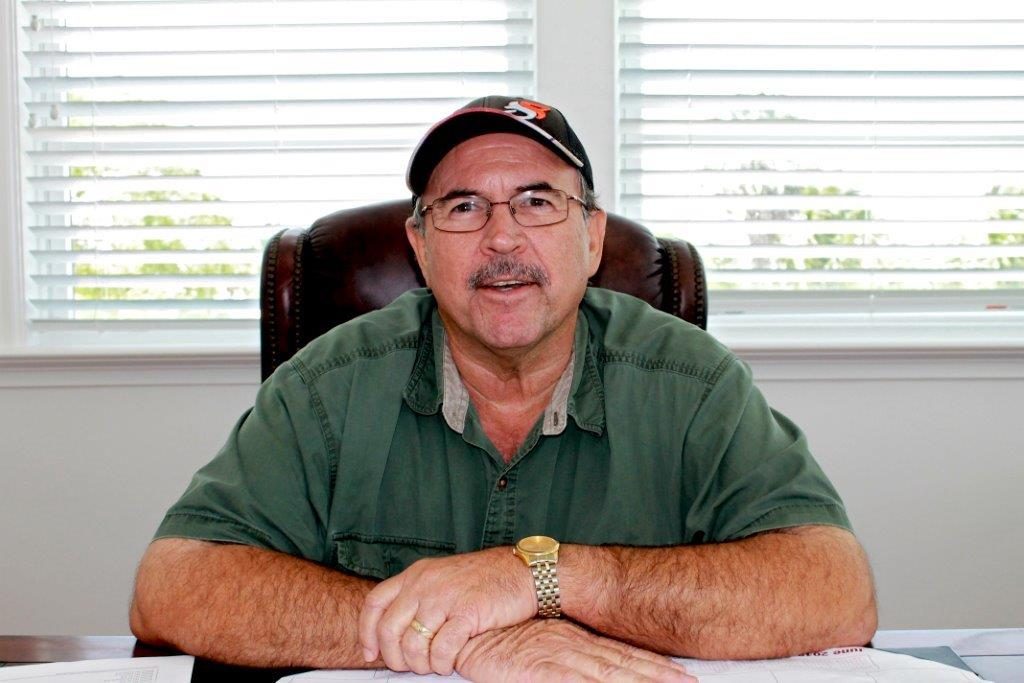
Everglades City Mayor Howie Grimm says the town will be better than before. Photo by Amy Green
Many in Everglades City hope to see faster progress as more densely populated areas such as Marco Island and Naples complete repairs and contractors look for work elsewhere, said Tony Pernas, chairman of a locally appointed committee overseeing the recovery.
“Ten years down the line, I think it’s going to be a much more resilient community. Everyone’s going to be up on stilts. There’s not going to be this panic the next time a hurricane comes, and we’re not going to have to worry about storm surge. The roads will probably be elevated,” said Pernas, a botanist at Big Cypress National Preserve.
“People are always drawn to the coast, and it’s pretty short-sighted that people are going to move inland to higher ground.”
The challenges experienced by the community raise questions about rebuilding in areas vulnerable to the more extreme weather events of climate change and also sea-level rise.
“It becomes a wicked problem,” said Chris Emrich, an associate professor of environmental science and public administration at the University of Central Florida’s National Center for Integrated Coastal Research.
“It’s an easy problem when we say, ‘Oh, we only have to move 400 people, and they would be safe.’ But it becomes wicked and confounding when we say, ‘It’s not just 400 people,’ “ Emrich explained. “It’s the livelihoods. It’s the culture. It’s all of the other things that turn just a simple answer into a more complex and devilish problem.”
The Scott administration has shown almost no leadership on these complex issues. The governor has doubted whether more extreme weather events and rising tides are threats, questioned whether human activity is speeding the Earth’s warming and banned words such as “climate change” and “global warming” from state reports and communications, as the Florida Center for Investigative Reporting revealed in 2015.
After touring Irma-related damage in the Florida Keys the same week the hurricane hit, the governor said, “Clearly our environment changes all the time, and whether that’s cycles we’re going through or whether that’s man-made, I wouldn’t be able to tell you which one it is.” Scott, a Republican, cannot seek a third term and is running this year against Democratic Sen. Bill Nelson.
“We’ve typically developed our law and policy on the assumption that the way the world is today probably is the way it’s going to be tomorrow,” said Ruppert of Florida Sea Grant.
The reality many Florida coastal communities will face is whether they can afford to remain where they are, he said.
Already there is evidence the risks of climate change and sea-level rise are affecting property values, and that will mean less tax revenue for infrastructure improvements that can mitigate problems such as the flooding associated with sea-level rise. It also is possible insurance and mortgage companies will withdraw from coastal areas.
“What the science tells us now is that the past is not necessarily a good guide to what is coming down the road in the future, and the more we acknowledge that reality, that is going to allow us to go forward and help people understand that if we’re going to rebuild here, maybe you’re going to be at higher risk and maybe you want to rethink that. Or maybe you want to rebuild differently,” Ruppert said. “I have no doubt that at some point there will be a significant change, and I’m not alone in believing that.”
___
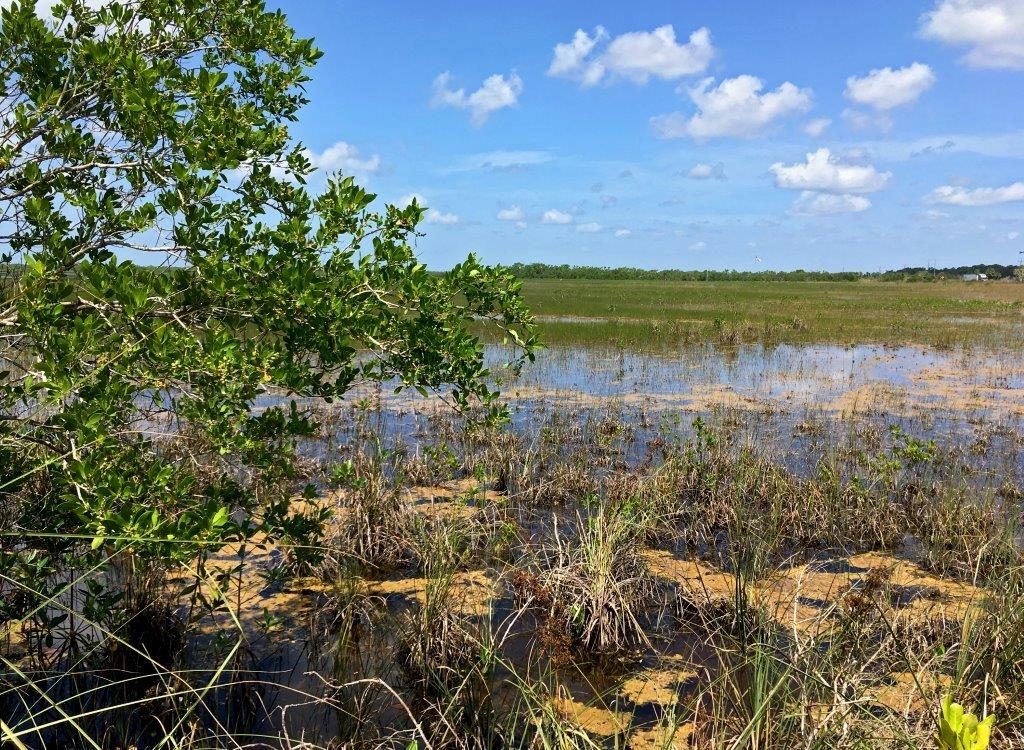
Just beyond Everglades City, growing thickets of mangroves are overtaking the sawgrass prairie as more salt water pushes farther inland. Photo by Amy Green
The sawgrass of the Everglades once unfurled green and vast from Everglades City to the horizon, a remarkable freshwater prairie beneath a blue dome of a sky.
Many locals describe their community as City of Everglades, although the watershed here is changing. Up the highway, growing thickets of mangroves, small trees that thrive in coastal brackish waters, are obscuring the horizon. The trees have found a place here as less freshwater flows from the north and more saltwater pushes inland. In some places, hundreds of thousands of mangroves have overtaken the prairie. The sawgrass that is the essence of the river of grass is disappearing.
Tina Collins stood in her front yard, at the intersection of Florida’s past and future, apologizing for an overgrown lawn as she considered the demolishment of her historic home and its reconstruction on stilts.
“Do I ever want to go through this again? No. I want my home raised up, whatever I have to do,” she said. “I don’t ever want to be a victim of flooding again.”
Like many residents, she and her husband have considered leaving Everglades City, but Richard is a fifth-generation resident and a third-generation stone crabber while she has her career at Big Cypress. The only life they know is here.
It’s a life in Florida whose future may no longer be certain in our warming world.
Amy Green covers the environment for WMFE. She is the author of a forthcoming book on the Everglades.
The Florida Center for Investigative Reporting is a nonprofit news organization supported by foundations and individual contributions. For more information, visit fcir.org.
